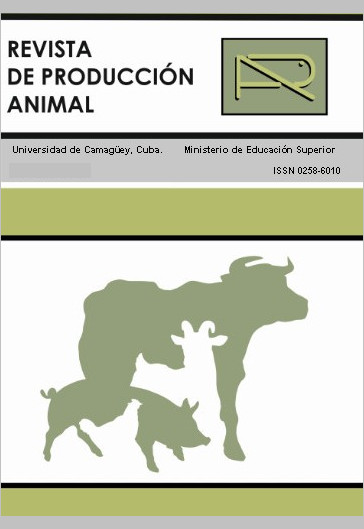Caracterización fenotípica de cepas autóctonas de Escherichia coli enterotoxigénicas 987P
Resumen
Se reporta el empleo de un fragmento del gen que codifica para la subunidad fímbrica 987P como sonda de ADN para detectar la presencia de cepas autóctonas 987P+ en 117 aislamientos de E. coli realizados en granjas porcinas de la provincia de Camagüey, Cuba. Del total de animales muestreados (77 cerdos neonatos), 4 (5,2 %) estaban infectados con cepas de E. coli portadoras del gen para la fimbria 987P, las que resultaron fenotípicamente 987P positivas por el sistema inmunoenzimático ELISA y Western-blot. Teniendo en cuenta los resultados obtenidos proponemos emplear la hibridación ADN-ADN para realizar un estudio epizootiológico más extenso, con el objetivo de conocer el grado de incidencia de la ECET 987P en la diarrea porcina en Cuba.
Descargas
Citas
BASULTO, R.; L. CALZADA, T. OLIVERA Y J. DE LA FUENTE: Detection of Genes for Fimbrial Antigens in Escherichia coli Isolated from Piglets with Diarrhea in Camagüey. Revista Biotecnología Aplicada. 14 (4): 237-241, 1997. BURNETTE, W. N.: "Western Blotting": Electroforetic Transfer of Proteins from SDS-PAGE to Unmodified Nitrocellulose and Radiographic Detection with Antibody and Radioiodinated Protein A. Anal. Biochem. 112: 195-203, 1981. DE GRAAF, F. K. Y P. KLAASEN: Nucleotide Sequence of the Gen Encoding 987P Fimbrial Subunit of E. coli. FEMS Microbiol. Lett. 42: 253-258, 1987. DEAN, E. A.: Comparison of Receptors for 987P Pili of Enterotoxigenic Escherichia coli in the Small Intestines of Neonatal and Older Pigs. Infect. Immunol. 58: 4030-4035, 1990. FEINBERG, A. P. Y B. A. VOGELSTEIN: A Technique for Radiolabelling DNA Restriction Endonuclease Fragment to High Activity. Anal. Biochem. 132: 6-13, 1984. GUINÉE, P. A. M.; W. H. JANSEN Y C. M. AGTERBERG: Detection of the K99 Antigen by Means of Agglutination and Immunoelectrophoresis in E. coli IsolateD from Calves and its Correlation with Enterotoxigenicity. Infect. Immun. 13: 13691377, 1976. HAREL, J.; H. LAPOINTE, A. FALLARA, L. A. LORTIE, M. BIGRAS-POULIN, S. LARIVIERE Y
J. M. FAIRBROTHER: Detection of Genes for Fimbrial Antigens and Enterotoxins Associated with E. coli Serogroup Isolated from Pigs with Diarrhea. J. Clin. Microbiol. 29: 745-752, 1991. MOL, O. Y B. OUDEGA: Molecular and Structural Aspects of Fimbriae Biosynthesis and Assembly in Escherichia coli. FEMS Microbiol. Rev. 19: 25-52, 1996. MOURICOUT, M.: Swine and Cattle Enterotoxigenic Escherichia coli Mediated Diarrhea. Development of Therapies Based on Inhibition of Bacteria-Host Interactions. Eur. J. Epidemiol. 7 (6): 588-604, 1991. RAYBOULD, T. J. G.; C. F. CROUCH Y S. D. ACRES: Monoclonal Antibody Passive Hemaglutination and Capture ELISA for Direct Detection and Quantitation of F41 and K99 Fimbrial Antigens in ETEC. J. Clin. Microbiol. 25: 278-284, 1987. SAMBROOK, J.; E. F. FRITSCH Y T. MANIATIS: Molecular Cloning: a Laboratory Manual, 3, 2 nd ed., p. 18.47-18.45. Cold Spring Harbor Laboratory Press. USA, 1989. SODERLIND, O.; B. THAFYELIN Y R. MOLLBY: Virulence Factor in E. coli Strain Isolated from Swedish Piglets with Diarrhea. J. Clin. Microbiol. 26: 879-884, 1988. VAN DER WOUDE, M.W.; F. K. DE GRAAF Y H. W. VERSEVELD: Production of the Fimbrial Adhesin 987P by ETEC During Growth under Controlled Conditions in a Chemostat. J. Gen. Microbiol. 135: 3421-3429, 1989.
Los autores de los artículos publicados en RPA retienen los derechos de autor de su trabajo, de marca y patente, y también sobre cualquier proceso o procedimiento descrito en el artículo, así como a compartir, copiar, distribuir, ejecutar y comunicar públicamente el artículo publicado en la RPA o cualquier parte de aquel siempre que indiquen la fuente de publicación (autores del trabajo, revista, volumen, número y fecha), pero están de acuerdo en que la revista publique los trabajos bajo una licencia Creative Commons.
![]() Licencia Attribution-NonCommercial 4.0 International (CC BY-NC 4.0)
Licencia Attribution-NonCommercial 4.0 International (CC BY-NC 4.0)






































